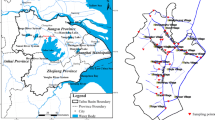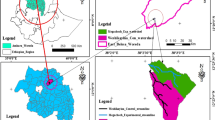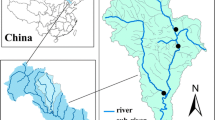Abstract
Urban rainfall-runoff pollution is one of the main reasons for the deterioration of the receiving water quality. In this study, the lower reaches of the Meishe River on Hainan Island, China were adopted as the research area, and palladium (Pd) was selected as the target pollutant. The purpose of this study was to construct an input response model and to examine the Pd response relationship of receiving water bodies under multiple scenario changes of rainfall-runoff pollution combined with scenario analysis methods. The results showed that the mean absolute percent error (MAPE) and relative mean square error (RMSE) of the input response model were within 15%, which demonstrated the reliability of the model when applied to the simulation of the response of Pd in receiving water bodies to rainfall runoff. The dissolved Pd concentration in the receiving water body decreased in the following order: the moderate rain scenario > rainstorm scenario > the heavy rain scenario. The suspended Pd concentration in the receiving water body first increased and then decreased, and its decay rate was closely related to rainfall intensity and duration. Under the heavy rain and rainstorm scenarios, within 20 m downstream from the outfall, the occurrence time of the maximum suspended Pd concentration in the receiving water body was inversely proportional to the distance. The number of previous clear days was inversely proportional to the dissolved Pd concentration in the receiving water body and proportional to the suspended Pd concentration in the receiving water body. Under the short period of previous clear day scenario, the maximum suspended Pd concentration in each section of the receiving water body appeared earlier than that under the moderate and long periods of previous clear day scenarios.







Similar content being viewed by others
Data availability
Since the data is completed by the cooperation of many scholars, the data set generated and/or analyzed in the current research process cannot be publicly obtained, but are available from the corresponding author on reasonable request.
References
Alfakhory AE, Leermakers M (2016) Development of DGT passive samplers for the platinum group elements Rh, Pt & Pd in river water. Chemistry Conference for Young Scientists, Blankenberge, Belgium. March 16-18, 40/278. doi:10.13140/RG.2.1.3455.3205
An Q, Wu Q, Li J, Xiong B, Chen X (2019) Environmental efficiency evaluation for Xiangjiang River basin cities based on an improved SBM model and global Malmquist index. Energy Econ 81:95–103. https://doi.org/10.1016/j.eneco.2019.03.022
Aruguete DM, Murayama M, Blakney T, Winkler C (2019) Enhanced release of palladium and platinum from catalytic converter materials exposed to ammonia and chloride bearing solutions. Environ Sci Process Impacts 21(1):133–144. https://doi.org/10.1039/c8em00370j
Bedri Z, Corkery A, O’Sullivan JJ, Alvarez MX, Erichsen AC, Deering LA, Demeter K, O’Hare GMP, Meijer WG, Masterson B (2014) An integrated catchment-coastal modelling system for real-time water quality forecasts. Environ Model Softw 61:458–476. https://doi.org/10.1016/j.envsoft.2014.02.006
Birke M, Rauch U, Stummeyer J, Lorenz H, Keilert B (2018) A review of platinum group element (PGE) geochemistry and a study of the changes of PGE contents in the topsoil of Berlin, Germany, between 1992 and 2013. J Geochem Explor 187:72–96. https://doi.org/10.1016/j.gexplo.2017.09.005
Chakarvorty M, Dwivedi AK, Shukla AD, Kumar S, Niyogi A, Usmani M, Pati JK (2015) Geochemistry and magnetic measurements of suspended sediment in urban sewage water vis-à-vis quantification of heavy metal pollution in Ganga and Yamuna Rivers, India. Environ Monit Assess 187(9):604. https://doi.org/10.1007/s10661-015-4794-x
Cobelo-García A, López-Sánchez DE, Almécija C, Santos-Echeandía J (2013) Behavior of platinum during estuarine mixing (Pontevedra Ria, NW Iberian Peninsula). Mar Chem 150:11–18. https://doi.org/10.1016/j.marchem.2013.01.005
Dong J, Chen Q, Zhang J, Wang Z, Cai J, Yan H, Chen C (2019) Effects of rainfall events on behavior of tetracycline antibiotics in a receiving river: seasonal differences in dominant processes and mechanisms. Sci Total Environ 692:511–518. https://doi.org/10.1016/j.scitotenv.2019.07.214
Du J, Wang YH, Huang QH, Dai Q, Yang YD (2019) Spatio-temporal variation characteristics and influencing factors of heavy metals in suspended matter in the Pearl River Estuary. Environmental Science 2019, 40 (2): 115-122. doi:10.13227/j.hjkx.201807028
Duvert C, Priadi CR, Rose AM, Abdillah A, Marthanty DR, Gibb KS, Kaestli M (2019) Sources and drivers of contamination along an urban tropical river (Ciliwung, Indonesia): insights from microbial DNA, isotopes and water chemistry. Sci Total Environ 682:382–393. https://doi.org/10.1016/j.scitotenv.2019.05.189
Fauvel B, Cauchie H-M, Gantzer C, Ogorzaly L (2016) Contribution of hydrological data to the understanding of the spatio-temporal dynamics of F-specific RNA bacteriophages in river water during rainfall-runoff events. Water Res 94:328–340. https://doi.org/10.1016/j.watres.2016.02.057
Fonseca A, Botelho C, Boaventura RAR, Vilar VJP (2014) Integrated hydrological and water quality model for river management: a case study on Lena River. Sci Total Environ 485-486:474–489. https://doi.org/10.1016/j.scitotenv.2014.03.111
Fu B, Liu Y, Zhao Z, Zhang L, Wu D, Liu H (2019) Dissolved palladium in heavy traffic location runoff: dynamic variation and influencing factors. Urban Water J 15(9):880–887. https://doi.org/10.1080/1573062x.2019.1579348
Hardy SD, Koontz TM (2007) Reducing nonpoint source pollution through collaboration: policies and programs across the U.S. states. Environ Manag 41(3):301–310. https://doi.org/10.1007/s00267-007-9038-6
Imteaz MA, Hossain I, Anwar AHMF (2015) Continuous simulations of nutrients and BOD through a stream section. Int J Water 9(2):144. https://doi.org/10.1504/ijw.2015.068957
Jurczak T, Wagner I, Kaczkowski Z, Szklarek S, Zalewski M (2018) Hybrid system for the purification of street stormwater runoff supplying urban recreation reservoirs. Ecol Eng 110:67–77. https://doi.org/10.1016/j.ecoleng.2017.09.019
Lee J, Bang K (2000) Characterization of urban stormwater runoff. Water Res 34(6):1773–1780. https://doi.org/10.1016/s0043-1354(99)00325-5
Li CR, Liu K, Lin JQ, Tang WH (2013) Characteristics of rainfall and runoff pollution on different underlying surfaces of Haikou City. Environmental Monitoring in China 29 (5): 80-83. doi: 10.3969 / j.issn.1002 -6002.2013.05.016.
Liu Y, Bralts VF, Engel BA (2015) Evaluating the effectiveness of management practices on hydrology and water quality at watershed scale with a rainfall-runoff model. Sci Total Environ 511:298–308. https://doi.org/10.1016/j.scitotenv.2014.12.077
Liu Y, Fu B, Shen Y, Yu Y, Liu H, Zhao Z, Zhang L (2018) Seasonal properties on PM 1 and PGEs (Rh, Pd, and Pt) in PM 1. Atmos Pollut Res 9(6):1032–1037. https://doi.org/10.1016/j.apr.2018.03.009
McKee LJ, Gilbreath AN (2015) Concentrations and loads of suspended sediment and trace element pollutants in a small semi-arid urban tributary, San Francisco Bay, California. Environ Monit Assess 187(8):499. https://doi.org/10.1007/s10661-015-4710-4
Motovilov YG, Fashchevskaya TB (2019) Simulation of spatially-distributed copper pollution in a large river basin using the ECOMAG-HM model. Hydrol Sci J 64(6):739–756. https://doi.org/10.1080/02626667.2019.1596273
Opher T, Ostfeld A, Friedler E (2009) Modeling highway runoff pollutant levels using a data driven model. Water Sci Technol 60(1):19–28. https://doi.org/10.2166/wst.2009.289
Pak G, Mallari KJB, Baek J, Kim D, Kim H, Jung M, Kim Y, Yoon J (2015) Modelling of suspended sediment in a weir reach using EFDC model. Water Sci Technol 73(7):1583–1590. https://doi.org/10.2166/wst.574
Ruchter N, Sures B (2015) Distribution of platinum and other traffic related metals in sediments and clams (Corbicula sp.). Water Res 70:313–324. https://doi.org/10.1016/j.watres.2014.12.011
Sen IS, Mitra A, Peucker-Ehrenbrink B, Rothenberg SE, Tripathi SN, Bizimis M (2016) Emerging airborne contaminants in India: Platinum Group Elements from catalytic converters in motor vehicles. Appl Geochem 75:100–106. https://doi.org/10.1016/j.apgeochem.2016.10.006
Song XX, Hou DB, Huang PJ, Zhang GX (2013) Research on dynamic early warning technology of water pollution emergency based on pollutant dispersion simulation. Appl Mech Mater 316-317:682–685. https://doi.org/10.4028/www.scientific.net/amm.316-317.682
Sun S, Barraud S, Castebrunet H, Aubin J-B, Marmonier P (2015) Long-term stormwater quantity and quality analysis using continuous measurements in a French urban catchment. Water Res 85:432–442. https://doi.org/10.1016/j.watres.2015.08.054
Suoranta T, Niemelä M, Poikolainen J, Piispanen J, Bokhari SNH, Meisel T, Perämäki P (2016) Active biomonitoring of palladium, platinum, and rhodium emissions from road traffic using transplanted moss. Environ Sci Pollut Res 23(16):16790–16801. https://doi.org/10.1007/s11356-016-6880-1
Sutherland RA (2007a) Platinum-group element concentrations in BCR-723: a quantitative review of published analyses. Anal Chim Acta 582:201–207. https://doi.org/10.1016/j.aca.2006.09.030
Sutherland RA (2007b) A re-examination of platinum-group element concentrations in the environmental certified reference material BCR-723. Int J Environ Anal Chem 87:501–520. https://doi.org/10.1080/03067310701336338
Sutherland RA, Pearson GD, Ottley CJ, Ziegler AD (2015) Platinum-Group Elements in Urban Fluvial Bed Sediments—Hawaii. In: Platinum-group elements in urban fluvial bed sediments—Hawaii. Platinum Metals in the Environment. Springer, Berlin Heidelberg. https://doi.org/10.1007/978-3-662-44559-4_12
Vanzo D, Siviglia A, Toro EF (2016) Pollutant transport by shallow water equations on unstructured meshes: hyperbolization of the model and numerical solution via a novel flux splitting scheme. J Comput Phys 321:1–20. https://doi.org/10.1016/j.jcp.2016.05.023
Walia S, Murleedharn C, Band J, Kanwar M, Kumar A (2016) Quantitation of antibiotic resistance genes pollution in hospital waste water effluent and Urban Clinton River Water, Michigan, USA. Curr Med Res Pract 6(4):149–151. https://doi.org/10.1016/j.cmrp.2016.07.005
Wiseman CL, Hassan PZ, Zereini F (2016) Platinum group element and cerium concentrations in roadside environments in Toronto, Canada. Chemosphere 145:61–67. https://doi.org/10.1016/j.chemosphere.2015.11.056
Xue C, Yin H, Xie M (2015) Development of integrated catchment and water quality model for urban rivers. Journal of Hydrodynamics. Ser B 27(4):593–603. https://doi.org/10.1016/s1001-6058(15)60521-2
Zereini F, Wiseman C L S, Poprizki J, Albers P, Schneider W, Leopold K (2016) Assessing the potential of inorganic anions (Cl−, \( {NO}_3^{-} \), \( {SO}_4^{2-} \)and\( {PO}_4^{3-} \)) to increase the bioaccessibility of emitted palladium in the environment: experimental studies with soils and a Pd model substance. Environmental Pollution Part B. 220: 1050-1058. doi:https://doi.org/10.1016/j.envpol.2016.11.039
Zhang H, Wang Y, Wang Y, Li D, Wang X (2013) Quantitative comparison of semi- and fully-distributed hydrologic models in simulating flood hydrographs on a mountain watershed in southwest China. Journal of Hydrodynamics. Ser B 25(6):877–885. https://doi.org/10.1016/s1001-6058(13)60436-9
Zhang L, Wang Y, Liu Y, Li Z, Li X (2018) Variation of platinum group elements (PGE) in airborne particulate matter (PM2.5) in the Beijing urban area, China: a case study of the 2014 APEC summit. Atmos Environ doi: https://doi.org/10.1016/j.atmosenv.2018.10.044, 198, 70, 76
Acknowledgements
We thank the 2017 undergraduates at the College of Geography and Environmental Science, Hainan Normal University, Youpeng Si, Yonghang Fan, Jie Zhang, Xinyue Wang, Mengyuan Jiang, and other students, who helped complete the sampling work.
Funding
This work was supported by the National Natural Science Foundation of China (41867060). Funding agencies provided complete sampling experimental conditions for the data in the manuscript, designed manuscript research ideas, and edited the manuscript.
Author information
Authors and Affiliations
Contributions
Fangfang Ding analyzed and interpreted the relevant pollutant data, and was a major contributor in writing the manuscript. Yuyan Liu provided a general framework and financial support. Lin Wang made important comments and reference suggestions in the later revision of the article. Haofeng Liu provided experimental test methods and added some experimental data in the later period. Caiye Ji proofreaded the manuscript and provided comments. Lan Zhang provided technical support. Dan Wu provided test venues.
Corresponding author
Ethics declarations
Ethics approval and consent to participate
Our manuscript does not report on or involve the use of any animal or human data or tissue. “Not applicable” in this section.
Consent for publication
Our manuscript does not contain data from any individual person. “Not applicable” in this section.
Conflict of interest
The authors declare no competing interests.
Additional information
Responsible Editor: Philippe Garrigues
Publisher’s note
Springer Nature remains neutral with regard to jurisdictional claims in published maps and institutional affiliations.
Rights and permissions
About this article
Cite this article
Ding, F., Liu, Y., Wang, L. et al. Analysis of the palladium response relationship of a receiving water body under multiple scenario changes in rainfall-runoff pollution. Environ Sci Pollut Res 28, 26684–26696 (2021). https://doi.org/10.1007/s11356-021-12597-3
Received:
Accepted:
Published:
Issue Date:
DOI: https://doi.org/10.1007/s11356-021-12597-3




